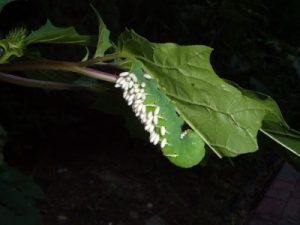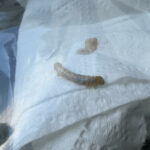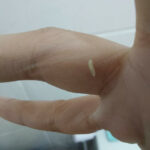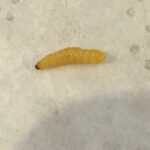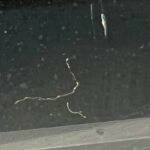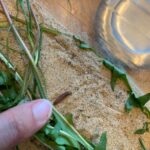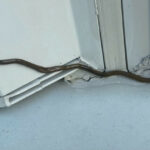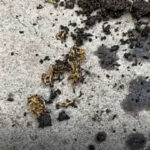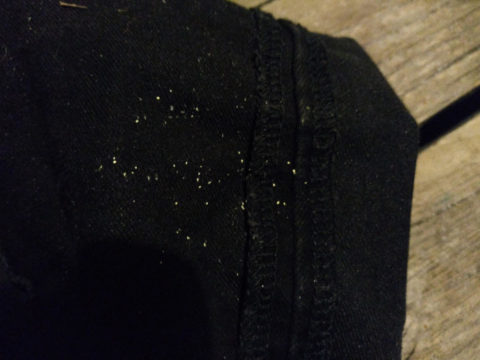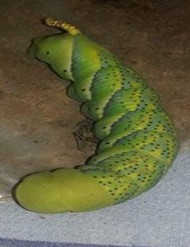
A woman sent us the photograph below of a handsome green critter she found in her garden, with the simple request that we identify it. Luckily, it’s a great photograph, and gives us some great clues about its identity. We can see several distinct characteristics to help us identify the species. The way the critter is segmented is helpful, as are the black spots on its body. But the most telling traits are the horn seen at the top of the picture and the stripes on the side of its body.
The general shape, coloring, and horn indicate to us that this guy is a tomato hornworm caterpillar (Manduca quinquemaculata). These are very common and the mortal enemies of gardeners all over North America. Much like its close relative the tobacco hornworm caterpillar (Manduca sexta), the tomato hornworm caterpillar is a voracious eater and can be very hard to find in a garden. This is somewhat ironic, since hornworm caterpillars are some of the largest caterpillars out there, but they’re very good at hiding. While many people would prefer not to share their garden with these little guys, not everyone hates hornworm caterpillars. There are those who cultivate them in the gardens, and some people keep them as pets! Both species are also commonly raised as a food source for reptiles.
Our reader has no reason to worry for her health or the health of her pets, as these are harmless to humans and animals. But, they will wreak havoc on a garden. If she’s having issues with the leaves and fruit being eaten, then this little guy is a likely culprit.
If she wants to evict the tomato hornworm caterpillar, there is a tried and true method called “hand picking.” Hand picking is a rather tedious process of looking through the leaves of the plants and literally picking the caterpillars out of the garden. She can then cut the worm in half and dispose of the body, or put them in a bucket of water.
When looking for hornworm caterpillars in her garden, she may encounter some that appear to have little tufts on cotton growing on them. If her goal is to eliminate the hornworm caterpillars then it’s a good idea to leave these in place. The tufts are the cocoons of the Braconid Wasp (Braconidae), a parasite that preys on hornworm caterpillars. Leaving an infected hornworm caterpillar in her garden can be a remarkably effective means of controlling these ravenous caterpillars.
A tomato hornworm caterpillar infested with parasitic wasps. Photo by Max Wahrhaftig (CC BY-SA 3.0)
All About Worms is always free, always reader-supported. Your tips via CashApp, Venmo, or Paypal are appreciated! Receipts will come from ISIPP Publishing.
You might also find these guys interesting!

